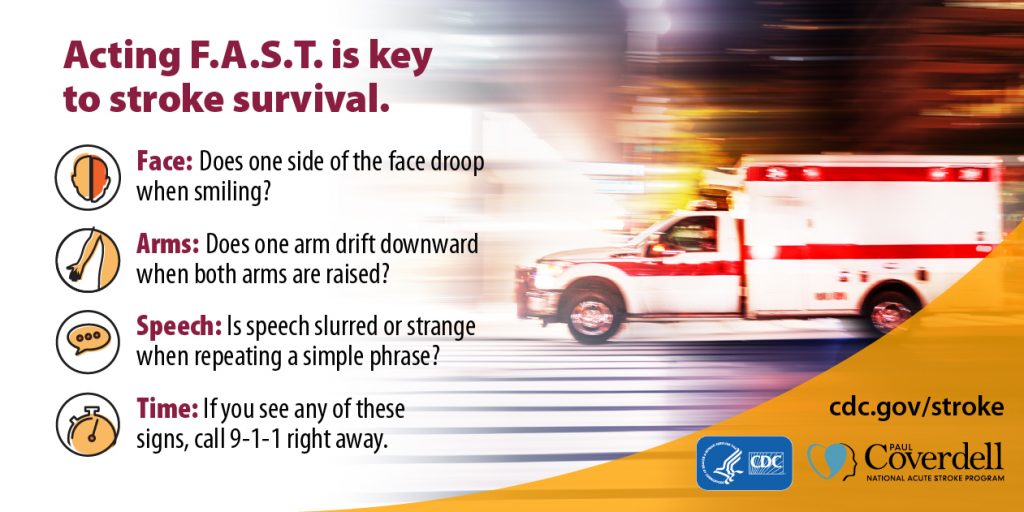May Is Stroke Awareness Month
Stroke is among the leading causes of death and disability across the nation and around the world, with someone in the United States suffering a stroke every 40 seconds. Strokes also cause one out of every 19 deaths nationwide, but research suggests that 80% of strokes are preventable.
May is Stroke Awareness Month, and learning how to spot the signs of stroke – and how to react when you see someone having one – can go a long way at minimizing the damage this type of medical emergency can cause. While learning how to spot and react to a stroke is critical, so, too, is learning how to reduce your own chances of suffering one.
Signs of a Stroke
When someone suffers a stroke, every minute counts. Getting a patient fast treatment has the potential to mean the difference between that patient suffering brain damage and that patient making a full recovery. Be aware of the fact that any of the following signs may indicate a stroke.
- Sudden weakness, and particularly on one side of the body
- Sudden vision issues
- Sudden confusion, as often evidenced by speech or comprehension issues
- Sudden trouble with mobility/walking
- Sudden severe headache with no obvious underlying cause
If you suspect someone is having a stroke, help them seek immediate medical attention. A patient’s chances of recovering improve significantly when that patient receives medical attention within three hours of symptoms becoming apparent.
What to Do if Someone Is Having a Stroke
The steps you take upon seeing someone have a stroke have far-reaching effects. If you suspect someone is having a stroke, take the following steps.
• Call for help. Regardless of whether you see someone exhibiting stroke symptoms or if you are the one having them, seek medical attention immediately.
• Check for breathing. Make sure the party you believe is having a stroke is breathing. If he or she is not breathing, perform CPR.
• Keep the party warm and comfortable – but don’t provide food or drink. Cover him or her with a blanket and try to have the person suffering a stroke lie on one side so that he or she does not choke if vomiting occurs. However, if the party having a stroke exhibits weakness anywhere, avoid moving him or her unless absolutely necessary.
• Observe any changes in condition and report them to medical professionals upon arrival.
Never take a “wait and see” approach when it comes to strokes. If you are unsure about whether someone is having a stroke, err on the side of caution and call in the professionals.
Ways to Prevent a Stroke
The vast majority of strokes are preventable, and there are many things you might do to reduce your risk. Take the following steps to reduce your own risk of suffering a potentially life-altering stroke.
Stay active
Staying fit and active has the potential to reduce your stroke risk by 25% – 30%. This doesn’t mean you have to take up running or hit the gym – even taking a simple walk each day helps you lower cholesterol and blood pressure and maintain a healthy weight – all of which impacts your stroke risk.

Follow a healthy diet
For many people, gaining weight is an unfortunate side effect of aging. While maintaining a healthy weight helps reduce your stroke risk, eating a nutritious diet with a heavy emphasis on fruits, veggies, whole grains and healthy proteins can work wonders in terms of reducing your stroke risk.
Maintain a healthy blood pressure
More than half of American men and 43% of American women have high blood pressure, which is the number-one cause of stroke in America. Everything from diet and obesity to cholesterol and diabetes impacts blood pressure, so it is important that you monitor yours and compensate for any sudden changes.
Quit smoking
Smoking raises stroke risks, and this is particularly true among Black Americans. Quitting smoking is a surefire way to reduce your risk of a stroke.
Start practicing healthy habits now
Many people mistakenly believe that they don’t need to worry about strokes until later in life. Yet, between about 10% and 15% of all stroke victims are under the age of 50. The incidence of stroke is even higher among Black Americans, with Black Americans facing about four times the stroke risk of White Americans.
While learning to recognize and react to signs of a stroke may help you save the life of someone else, learning how to reduce your own stroke risks has the potential to save your own.







